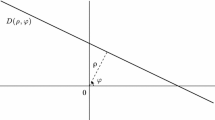Abstract
Using the a-contrario framework recently introduced in the modeling of human visual perception, we build a statistical model to predict the detectability of a spot on a textured background. Contrary to classical formalisms (ideal observer and its extensions), which assume a known probability distribution for the signal to be detected, the a-contrario observer we build only relies on gestalt-driven measurements and on an approximate representation of the background texture. It extends the scope of previous a-contrario detectors by using a non-i.i.d. naive model and a notion of local context. The models we propose are first validated theoretically in the case of powerlaw textures, which are, in particular, classical models for mammograms. Then, going to more general microtextures (colored noise processes), we compute the relationship between the size of a spot and the minimum contrast required to reach a given detectability threshold according to the a-contrario observer. Three main types of microtextures pop out from this characterization, and in particular low-frequency textures for which curiously enough, the contrast being given, the most salient spots are the smallest ones. Last, we illustrate the interest of the a-contrario observer for two real applications: the detectability of opacities in mammograms and the perception of stains on pieces of clothing.
Similar content being viewed by others
References
Alvarez, L., Gousseau, Y., Morel, J.-M.: The size of objects in natural and artificial images. Adv. Imaging Electron Phys. 111, 167–242 (1999)
Barrett, H.H., Yao, J., Rolland, J.P., Myers, K.J.: Model observers for assessment of image quality. Proc. Natl. Acad. Sci. USA 90, 9758–9765 (1993)
Benjamini, Y., Hochberg, Y.: Controlling the false discovery rate: a practical and powerful approach to multiple testing. J. R. Stat. Soc. Ser. B 57, 289–300 (1995)
Brodatz, P.: Textures: A Photographic Album for Artists and Designers. Dover, New York (1966)
Burgess, A.E.: Mammographic structures: data preparation and spatial statistics analysis. In: Hanson, K. (ed.) Medical Imaging 1998, Image Processing. Proceedings of the Society of Photo-optical Instrumentation Engineers, vol. 3661, pp. 642–653. Society of Photo Optical, San Diego (1998)
Burgess, A.E., Jacobson, F.L., Judy, P.F.: Human observer detection experiments with mammograms and power-law noise. Med. Phys. 28(4), 419–437 (2001)
Burgess, A.E., Jacobson, F.L., Judy, P.F.: Lesion detection in digital mammograms. In: Proceedings of SPIE, Medical Imaging, vol. 4320, pp. 555–560. SPIE, Bellingham (2001)
Desolneux, A., Moisan, L., Morel, J.-M.: Meaningful alignments. Int. J. Comput. Vis. 40(1), 7–23 (2000)
Desolneux, A., Moisan, L., Morel, J.-M.: Edge detection by Helmholtz principle. J. Math. Imaging Vis. 14, 271–284 (2001)
Desolneux, A., Moisan, L., Morel, J.-M.: Computational gestalts and perception thresholds. J. Physiology 97(2–3), 311–324 (2003). Paris, special issue on neurogeometry and visual perception
Desolneux, A., Moisan, L., Morel, J.-M.: In: From Gestalt Theory to Image Analysis—A Probabilistic Approach. Interdisciplinary Applied Mathematics, vol. 34. Springer, New York (2008)
Dibos, F., Pelletier, S., Koepfler, G.: Real-time segmentation of moving objects in a video sequence by a contrario detection. In: Proceedings of Int. Conf. Image Processing, vol. 1, pp. 1065–1068 (2005)
Eckstein, M.P., Abbey, C.K., Bochud, F.O.: In: Beutel, J., Kundel, H.L., Van Metter, R.L. (eds.) A practical guide to model observers for visual detection in synthetic and natural noisy images. Handbook of Medical Imaging Physics and Psychophysics, pp. 593–628. SPIE Press, Bellingham (2000). Chap. 10
Gandhi, P.P., Kassam, S.A.: Analysis of CFAR processors in nonhomogeneous background. IEEE Trans. Aerosp. Electron. Syst. 24(4), 427–445 (1988)
Grosjean, B., Muller, S., Souchay, H.: Lesion detection using an a-contrario detector in simulated digital mammograms. In: Proceedings of SPIE, Medical Imaging, vol. 6146, pp. 216–227. SPIE, Bellingham (2006)
Heine, J.J., Velthuizen, R.P.: Spectral analysis of full field digital mammography data. Med. Phys. 29(5), 647–661 (2002)
Kanizsa, G.: Grammatica del Vedere (La grammaire du voir, Diderot Editeur, Arts et Sciences, 1996). Il Mulino, Bologna (1980)
Kay, M.: Fundamentals of statistical signal processing. In: Detection Theory, vol. II. Prentice Hall, Englewood Cliffs (1998)
Khurd, P., Gindi, G.: Decision strategies that maximize the area under the LROC curve. IEEE Trans. Med. Imag. 24(12), 1626–1636 (2005)
Kotre, C.J.: The effect of background structure on the detection of low contrast objects in mammography. Br. J. Radiol. 71, 1162–1167 (1998)
Moisan, L., Stival, B.: A probabilistic criterion to detect rigid point matches between two images and estimate the fundamental matrix. Int. J. Comput. Vis. 57(3), 201–218 (2004)
Robey, F.C., Fuhrmann, D.R., Kelly, E.J., Nitzberg, R.: A CFAR adaptive matched filter detector. IEEE Trans. Aerosp. Electron. Syst. 28(1), 208–216 (1992)
Rose, A.: Sensitivity performance of the human eye on an absolute scale. J. Opt. Soc. Am. 38, 196–208 (1948)
Ruderman, D.: Origins of scaling in natural images. Vis. Res. 73(3), 814–817 (1996)
Swensson, R.G.: Using localization data from image interpretation to improve estimates of performance accuracy. Med. Decis. Mak. 20, 170–185 (2000)
Tilie, S., Laborelli, L., Bloch, I.: A contrario false alarms removal for improving blotch detection in digitized films restoration. In: Proceedings of 6th EURASIP Conference focused on Speech and Image Processing, Multimedia Communications and Services—IWSSIP, pp. 410–413 (2007)
Van Trees, H.L.: Detection, Estimation and Modulation Theory, Part 1. Wiley, New York (1968)
Veit, T., Cao, F., Boutemy, P.: An a-contrario decision framework for region-based motion detection. Int. J. Comput. Vis. 68(2), 163–178 (2006)
Xue, F., Liu, Q., Froment, J.: An a-contrario approach for parameters estimation of a motion-blurred image. In: Lecture Notes in Computer Science, vol. 4679, pp. 267–279. Springer, Berlin (2007)
Author information
Authors and Affiliations
Corresponding author
Rights and permissions
About this article
Cite this article
Grosjean, B., Moisan, L. A-contrario Detectability of Spots in Textured Backgrounds. J Math Imaging Vis 33, 313–337 (2009). https://doi.org/10.1007/s10851-008-0111-4
Received:
Accepted:
Published:
Issue Date:
DOI: https://doi.org/10.1007/s10851-008-0111-4




